
Support justice-driven, accurate and transparent news — make a quick donation to Truthout today!
What started as a Twitter conversation on the #usofscience hashtag during the inauguration of President Trump morphed into an estimated 610 marches for science yesterday — including at the North Pole and Antarctica. Supported by 170 partner organizations, thousands descended on the Capitol to declare a belief in and/or passion for science and truth in defiance of what’s being called the most anti-science administration in history.
During the campaign, Trump showed a propensity for shirking and outright denying scientific facts, particularly on the environment and health care. Then, in March, the White House budget blueprint off a new ripple of fear in the science community in response to the massive cuts to government-funded medical and scientific research — nearly across the board. He takes specific aim at the Environmental Protection Agency (EPA) as well as the National Institutes of Health, which stands to lose one-fifth of its budget — nearly $6 billion.
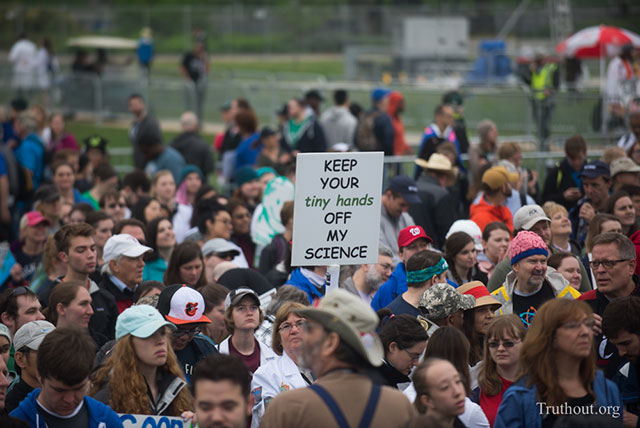 The marchers, who numbered in the thousands, held creative signs in solidarity with science and scientists, often mocking the president who has put it under threat. (Photo: Zach Roberts)
The marchers, who numbered in the thousands, held creative signs in solidarity with science and scientists, often mocking the president who has put it under threat. (Photo: Zach Roberts)
Much like those who came out for the Women’s Marches in January, participants have been activated by a fear of the effect these cuts could have on their immediate lives as well as future generations. Official estimates of the Washington, DC, crowd were unavailable (March For Science has not returned requests for information or comment), but some outlets estimate 40,000 people attended, and participants and reporters for Truthout confirm that thousands of all ages and backgrounds showed up in inclement weather for speakers, teach-ins, and — of course — to shout with signs.
A few science celebrities were among those marching and participating in teach-ins. Bill Nye the Science Guy was making the rounds, and speakers included astronaut Leland Melvin, President and CEO of Defenders of Wildlife Jamie Rappaport Clark, and Christiana Figueres, the former executive secretary of the United Nations Framework Convention on Climate Change (UNFCCC), who is known for her leadership on the Paris Climate Agreement.
Satellite marches around the country saw massive turnouts that rivaled the Women’s March. According to KBPS local news, an estimated 15,000 people gathered downtown San Diego for the local march. And According to the Associated Press, at least 10,000 marched in St. Paul, Minnesota.
 Thousands packed in close to hear the musicians and speakers at the first ever DC March for Science. (Photo: Zach Roberts)
Thousands packed in close to hear the musicians and speakers at the first ever DC March for Science. (Photo: Zach Roberts)
Many marchers, like progressive consulting firm founder, activist and mom Morgan Meneses-Sheets, was present for multiple reasons.
“This march is about making sure that our policies based in facts, but also that they are also aimed at improving people’s lives,” said Meneses-Sheets. “Science helps to make advances like the medicine that saved my daughter’s life and allows us to manage her health.”
 A man in the audience at the DC Science March holds up a sign that references President Trump calling Secretary Clinton a “nasty woman.” (Photo: Zach Roberts)
A man in the audience at the DC Science March holds up a sign that references President Trump calling Secretary Clinton a “nasty woman.” (Photo: Zach Roberts)
As a reproductive justice advocate, Meneses-Sheets spends a fair amount of her time fighting policies and laws that are not founded in fact and science, but it’s not just access to health care that concerns her.
“When we have leaders who ignore science and reason we end up with policies that perpetuate a system where only some people have access to clean water or can have their kids play outside without worrying about the air they are breathing,” she said. “We can’t just stand by as pipelines pollute sacred Indigenous lands and corporate interests are prioritized over public health.”
Congressional leadership in the House Committee on Science, Space, and Technology has paid lip service to the protesters. Chairman Rep. Lamar Smith (R-Texas) issued a statement following the march:
I support the right of science supporters to gather and march this weekend. Opening new frontiers of scientific knowledge, on Earth and beyond, will pave the way to a better, more secure future for the next generation. I will continue to support scientific research that furthers our national interest and is of the highest intellectual merit … I look forward to continuing to promote scientific integrity and a healthy, transparent and vibrant research and technology environment in the United States.
However, marchers and others will likely find little comfort in this statement, considering Smith opened a hearing on Climate Change and the Scientific Method by saying, “Much of climate science today seems to be based more on exaggerations, personal agendas, questionable predictions than on scientific methods.”
Protest participant Sarah Patton referenced this disconnect when asked why she attended.
“Just because of all the denial! This is our future — this is the thing that we live, eat, breath,” said Patton. “Instead of saying ‘No, it’s not real,’ we just need to stop and say [to legislators] ‘You need to listen!'”
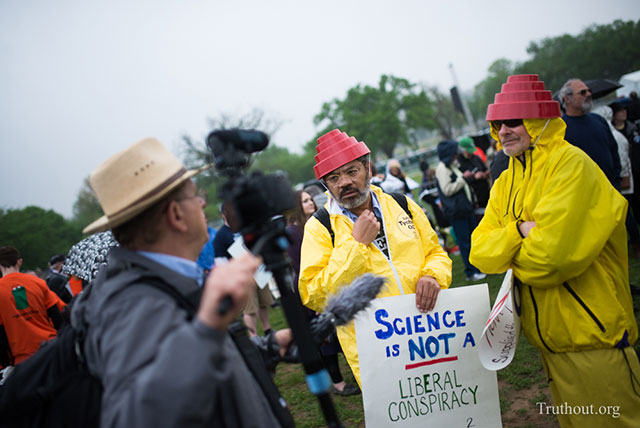 Two men are interviewed wearing Devo hats and yellow jumpsuits. Creative outfits at the march included anything from white lab coats to cartoon characters. (Photo: Zach Roberts)
Two men are interviewed wearing Devo hats and yellow jumpsuits. Creative outfits at the march included anything from white lab coats to cartoon characters. (Photo: Zach Roberts)
Patton says she will definitely continue to stay active.
“That’s most important,” she said. “The moment we stop making noise — the moment we stop talking is the moment the people lose their voice. And that’s something we can’t afford. We’re going to be keeping active, working with my daughter; she’s very active so we just keep moving forward the best we can.”
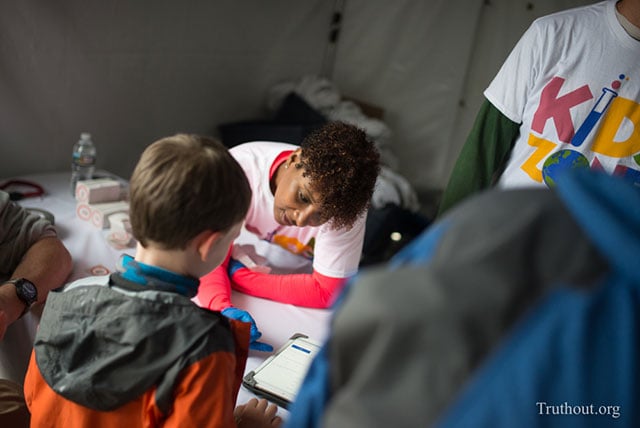 One of the many teach-in tents at the DC March for Science was created just for kids who got to try out several experiments with the help of volunteers. (Photo: Zach Roberts)
One of the many teach-in tents at the DC March for Science was created just for kids who got to try out several experiments with the help of volunteers. (Photo: Zach Roberts)
University of New Hampshire scientist David Ruth was marching for the first time “to try and support my brethren in the scientific community.” He noted that the political rhetoric going back to last year “has been a catalyst” for getting involved, himself included.
“I’m a grad student working on my doctorate in nuclear physics, and I’m here because currently this administration is pushing a budget and rhetoric that threatens to cut like $35 billion in science funding,” he said. “My group personally is doing research on the structure of nucleons and Trump wants to reallocate funding in the DOE [Department of Energy] from to nuclear weapons development, which I think is dangerous. Science has a done a lot to create modern civilization, and I think it’s appalling that not just he, but lawmakers now for decades, have been objecting scientific consensus.”
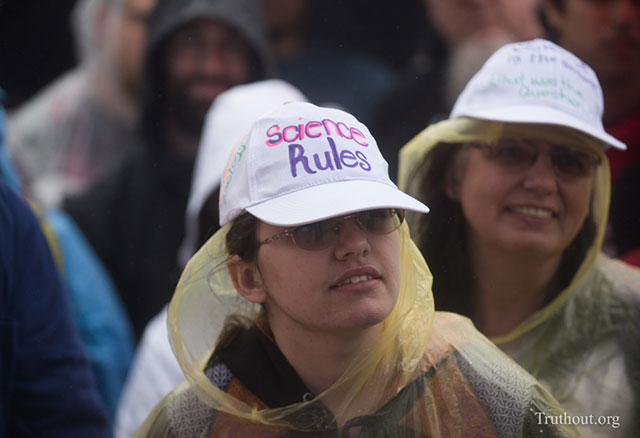 Very few of the hats, signs and t-shirts at the march were professionally made; people showed their own creativity on what they were wearing. (Photo: Zach Roberts)
Very few of the hats, signs and t-shirts at the march were professionally made; people showed their own creativity on what they were wearing. (Photo: Zach Roberts)
Students in middle and high school came out of concern for the future options and the world that they’ll inherit. Athena Czerwinski Burkard of Syracuse, New York, who plans to attend John Hopkins next year, was marching for the first time.
“I do, definitely plan to stay involved,” said Czerwinski, who takes the opportunities presented by social media to talk with friends and watch for more chances to get active.
“Originally, when I was younger, I wanted to be involved in climate science or something in climate change; that definitely hasn’t changed,” she said. “I was also looking at public health — it’s really been impacted by what [the Trump] administration is considering doing.”
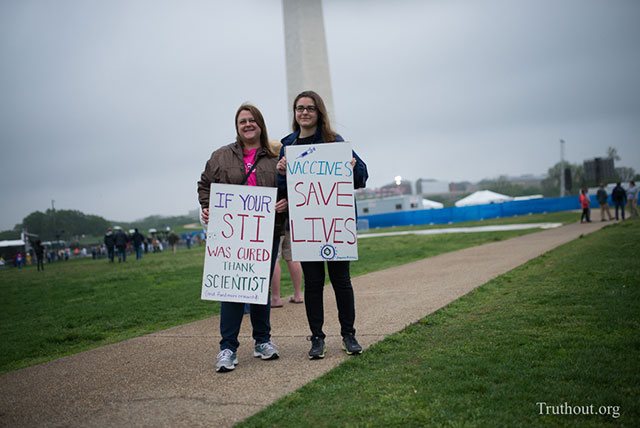 Athena and Maria from New York were early to the march, holding homemade signs that expressly expressed why saving science was worth it: it’s good for your health. (Photo: Zach Roberts)
Athena and Maria from New York were early to the march, holding homemade signs that expressly expressed why saving science was worth it: it’s good for your health. (Photo: Zach Roberts)
 Some people were just angry, and came to the protest to show it — in good humor. (Photo: Zach Roberts)
Some people were just angry, and came to the protest to show it — in good humor. (Photo: Zach Roberts)
The Science Community Is Not Immune to Perpetuating Oppressive Systems
Unfortunately, even in the scientific community — which, from the outside, is often assumed to be immune to issues affecting culture more broadly — exclusion of marginalized voices remains the norm and the March For Science has not been without criticism for perpetuating this issue.
Jacquelyn Gill (who was unable to respond to Truthout at deadline), an ice age ecologist and assistant professor at the University of Maine, made a public statement via Twitter this week about her involvement with and departure from March For Science: “I left the @ScienceMarchDC organizing committee in March due to a toxic, dysfunctional environment and hostility to diversity and inclusion.”
 A marcher holds up a sign that portrays cartoon character Ms. Frizzle as Lady Liberty. (Photo: Zach Roberts)
A marcher holds up a sign that portrays cartoon character Ms. Frizzle as Lady Liberty. (Photo: Zach Roberts)
She explained that her involvement began during the #usofscience conversation during the inauguration when she and another scientist (@LadyNaturalist) tweeted about a science march. The conversation picked up steam and they were approached by another group about joining forces.
“That other group became the leadership of the #ScienceMarch. Many of us struggled to find footing as the organization exploded overnight … Many of us were outspoken about the need to have diversity, inclusion, and accessibility built into the structure from day one.”
Gill said she hoped that March for Science would learn from the Women’s March and avoid their mistakes. Unfortunately, as time passed, “diversity and inclusion work was increasingly compartmentalized, and decisions made without our input.” She quotes several in leadership positions as saying, in effect, “diversity is a distraction from the real work of the march. We’re trying to save science.”
 While most of the signs at the climate march were science-based, some drifted into politics and crude humor. (Photo: Zach Roberts)
While most of the signs at the climate march were science-based, some drifted into politics and crude humor. (Photo: Zach Roberts)
Gill and others who have spoken out — including biological anthropologist Claudia M. Astorino, have said publicly that they left the organizing committees due to a lip service style tribute with no real input paid to diversity, disability and inclusion.
“I was so incredibly excited to work w #ScienceMarch, [especially] to work on Diversity team to prevent the mistakes #WomensMarch made,” Astorina said on Twitter, “but early on, diversity issues were ignored, backburnered for tasks perceived as more [important]…”
Astorina explained that there was “always another more pressing issue” and eventually, “it [became] clear that, while diversity was said to be a top priority, when it came to truly centralizing it, there was never time/interest. [T]here were major fails on race, sex, queer issues, and ESPECIALLY disability. [The Diversity team] attempted to try to correct again and again. [W]e were told our diversity platform (i.e. what centralizing diversity actually looks like) was too radical, non-partisan to promote.”
Eventually, Astorina stepped down as well.
“I kept thinking about all the times #ScienceMarch apologized for diversity fails while doing the same over & over, apologizing again & again,” she said, encouraging people to learn about their satellite marches. “[T]o all choosing to march, I hope you have a great day. [F]or those of you who choose not to, I complete respect & understand your decision. happy marching or not, y’all… [peace emoji].”
Jacquelyn Gill penned a full breakdown of how the “war on science” affects us all the day before the march, and J. Ama Mantey, Ph.D. took on the centering of whiteness in the march for The Root.
It’s easy for those who are not directly engaged with the scientific community, academia and STEM fields to presume from afar that arenas where facts are forefront, discrimination is a non-issue. Hopefully, one of the things that can be learned from the Science March is that no area is immune from colonialism, capitalism, patriarchy, ableism, racism and other oppressive systems; organizing efforts will always need include the job of dismantling them.
Organizers at March For Science say this is just the kickoff; they seek to “[turn] a march into a movement.” Among their goals — which fall under the heading “Champion Science For The Common Good” — are to “empower supporters to take informed political actions; connect communities around local and national issues, and engage the public to support diversity, access, literacy, and education” in STEM fields. They’ve created a number of resource tools and a way to connect to local groups which can remain loosely affiliated with the larger organization.
It remains to be seen whether these groups or others can harness the passion about science that has been sparked by the ignorance and opposition in the current administration and legislature.
![A group of friends cosplaying as scientists march with their friend, Tom Healey [center] who actually is a scientist. (Photo: Zach Roberts)](https://truthout.org/app/uploads/legacy/images/images_2017_04/2017_0423sc_02.jpg) A group of friends cosplaying as scientists march with their friend, Tom Healey [center] who actually is a scientist. (Photo: Zach Roberts)
A group of friends cosplaying as scientists march with their friend, Tom Healey [center] who actually is a scientist. (Photo: Zach Roberts)
Press freedom is under attack
As Trump cracks down on political speech, independent media is increasingly necessary.
Truthout produces reporting you won’t see in the mainstream: journalism from the frontlines of global conflict, interviews with grassroots movement leaders, high-quality legal analysis and more.
Our work is possible thanks to reader support. Help Truthout catalyze change and social justice — make a tax-deductible monthly or one-time donation today.